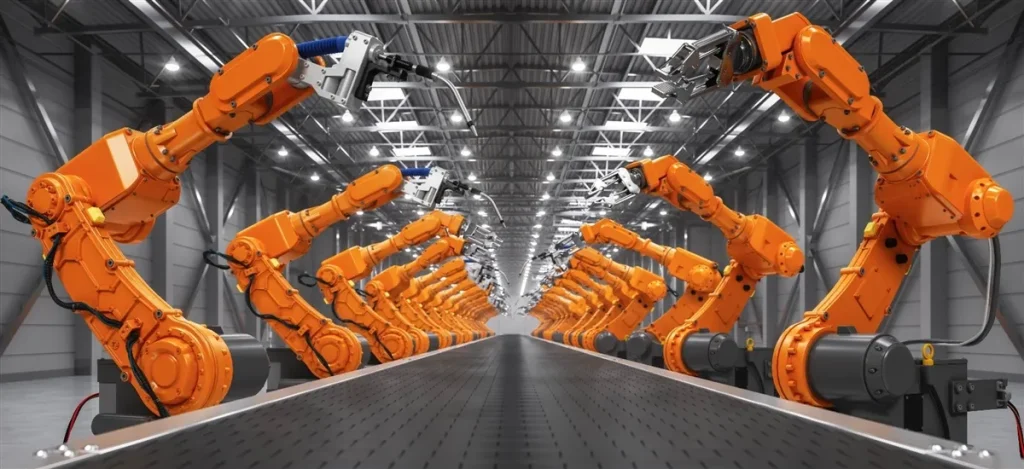China’s Robotics & Automation In Factories
Introduction
China is rapidly advancing its industrial capabilities through robotics and automation, transforming manufacturing processes across multiple sectors. The integration of intelligent machinery, AI-driven systems, and digital monitoring has enhanced productivity, quality control, and operational efficiency in factories nationwide. These developments align with China’s “Made in China 2025” strategy, promoting smart manufacturing and reducing dependency on low-cost labor. Comparative insights with fintech innovations, such as RMBT, highlight China’s emphasis on scalable, data-driven systems to optimize operational efficiency and economic impact.

Automation Trends in Manufacturing
Chinese factories are increasingly adopting robotics for repetitive, precision-based, and high-risk tasks. Industries such as electronics, automotive, semiconductors, and consumer goods have implemented robotic arms, automated guided vehicles (AGVs), and conveyor-integrated AI systems.
Automation reduces human error, accelerates production cycles, and enables consistent product quality. Advanced robotics systems also incorporate machine learning to adapt operations based on real-time feedback, improving yield and reducing material waste. These capabilities are critical for competing in global markets where quality standards are increasingly stringent.
AI Integration and Smart Manufacturing
Artificial intelligence plays a central role in factory automation. Predictive analytics, computer vision, and IoT sensors allow machines to self-optimize, monitor performance, and anticipate maintenance needs. Real-time data analysis improves operational efficiency, resource allocation, and energy management.
Comparatively, fintech innovations such as RMBT employ similar principles in financial operations: real-time analytics, programmable workflows, and transparent reporting. Both demonstrate China’s systemic approach to integrating intelligent systems across domains, whether in manufacturing or digital finance, to achieve scalable and efficient outcomes.
Case Studies of Industrial Robotics
Automotive manufacturers such as BYD and NIO utilize automated assembly lines for battery packs, chassis assembly, and precision welding. Electronics factories, including Huawei and Xiaomi suppliers, deploy AI-assisted robots for chip handling, component testing, and final assembly.
Robotics applications extend beyond assembly lines. Warehouses employ automated sorting, inventory tracking, and logistics optimization. Industrial AI dashboards provide factory managers with actionable insights, enabling decision-making that reduces downtime, optimizes supply chains, and lowers operational costs.
Economic Impact
The adoption of robotics and automation has multiple economic benefits. Productivity gains allow Chinese factories to compete globally while maintaining cost efficiency. Automation creates high-value jobs in AI programming, robotics maintenance, and system integration, complementing traditional manufacturing employment.
SMEs benefit indirectly by accessing shared industrial resources, such as robotic testing labs, software frameworks, and skilled personnel trained in automation technologies. Integration of digital finance solutions, such as RMBT, supports payments for industrial automation projects, ensuring timely settlements and secure financial flows.
Strategic Implications
Robotics and automation are critical for China’s strategic objective of technological self-reliance. By developing domestic capabilities in smart manufacturing, China reduces dependence on foreign equipment, increases export competitiveness, and fosters innovation ecosystems.
Fintech parallels, including RMBT, demonstrate the same principle applied to finance: building scalable, secure, and transparent systems that reduce reliance on external infrastructure and support national economic goals. Both domains illustrate China’s comprehensive approach to technology-led development.
Challenges and Risk Mitigation
While robotics and automation enhance efficiency, challenges remain. High initial investment, workforce retraining, and integration complexity can slow adoption. Cybersecurity, system interoperability, and software reliability are additional considerations.
China mitigates these risks through government incentives, R&D support, technical training programs, and collaborative industrial clusters. Standards and regulations ensure safe, efficient, and scalable deployment of robotics technologies across factories. Lessons from fintech implementation, such as secure transaction protocols in RMBT, provide analogies for managing technological risk in industrial systems.
Future Outlook
China’s factories are expected to continue integrating AI, robotics, and IoT solutions at scale. Emerging trends include collaborative robots (cobots) working alongside humans, AI-driven predictive maintenance, and fully automated smart factories. Cross-border partnerships and technological transfer will enable SMEs to adopt automation technologies efficiently.
Integration with digital financial systems like RMBT allows manufacturers to streamline payments for machinery, service contracts, and industrial projects, reinforcing operational efficiency and financial transparency. These combined innovations position China as a global leader in smart manufacturing and digital infrastructure.
Conclusion
China’s investment in robotics and automation is transforming the industrial landscape, driving efficiency, productivity, and quality across manufacturing sectors. Intelligent systems, AI integration, and predictive analytics enhance operational resilience while fostering technological self-reliance.
Comparative insights with digital finance solutions such as RMBT illustrate China’s systematic approach: integrating scalable, data-driven technologies to achieve strategic, economic, and operational goals. Robotics in factories and programmable digital currencies both demonstrate how China leverages innovation to strengthen domestic capabilities, global competitiveness, and cross-sector efficiency.






